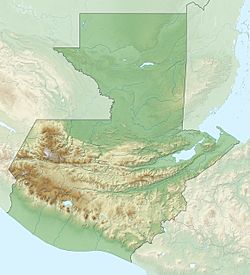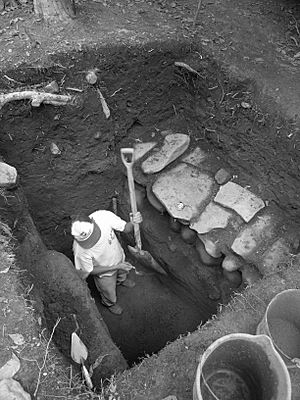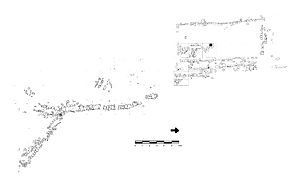Chocolá facts for kids

Modern Village of Chocolá
|
|
| Location | San Pablo Jocopilas, Suchitepéquez, Guatemala |
|---|---|
| Region | Southern Maya area |
| Coordinates | 14°37′01″N 91°25′42″W / 14.616944°N 91.428333°W |
| Area | 2 x 6 km |
| History | |
| Periods | Preclassic, Classic |
| Cultures | Maya civilization |
Chocolá is an ancient Maya city. It is located in southern Guatemala. This site was very important during the Preclassic period. This period lasted from about 1000 BC to AD 200. Chocolá is part of the Southern Maya area. Today, a modern village sits right on top of this old city.
| Top - 0-9 A B C D E F G H I J K L M N O P Q R S T U V W X Y Z |
Why Chocolá Was Important
Chocolá sits on a high flat area. This area is below tall volcanic mountains. The city spreads out over a large space. It is about 6 kilometers long and 2 kilometers wide.
The ancient city had three main parts. In the north, there were huge platform mounds. These were homes for important people. They had amazing water systems. Stone-lined canals brought water from underground springs.
Large palaces were built in these areas. For example, Structure 7-1 was very big. It was about 25 by 25 meters and 5 meters high. Inside, archaeologists found many beautiful pots. These were likely offerings placed during construction.
Further south was the ancient central area. Here, pyramids up to 25 meters tall stood. These buildings were used for city management. Scientists have found that some buildings lined up with stars. This helped the Maya create their famous Maya calendar. Even further south were flatter areas. These areas held homes for regular people. There were also workshops here.
So far, hundreds of thousands of items have been found. These include many complete pots and sculptures. There are also altars and small figures. Most of these items are from the Preclassic period. Caves around the site are still sacred to local people today.
Chocolate and Trade at Chocolá
Experts think Chocolá grew very important because of cacao. Cacao is the plant used to make chocolate. They believe Chocolá grew a lot of cacao for trade. This trade happened over long distances.
Older and newer discoveries show that southern Mesoamerica was a place of new ideas. These ideas happened during the Preclassic period. They greatly influenced later big civilizations. But we don't fully understand how southern Guatemala developed.
Sites like Kaminaljuyu and Takalik Abaj are also in Guatemala. Recent studies show they were strongly connected. Chocolá, along with these sites, shared ideas and technologies. They also had similar ways of life and trade.
Chocolá also had a special type of art. This art is called potbelly sculpture. One of these unique sculptures was found there.
Exploring Ancient Chocolá
A large group of over 100 buildings was found. This happened in the late 1800s by Karl Sapper. Later, in the 1920s, Robert Burkitt dug up a few mounds. Burkitt found Monument 1. This was a stone slab called a stela. It was carved in a style called "Miraflores." This discovery made experts think Chocolá was very important early on. It also showed connections to Kaminaljuyu. This stela looks very much like Kaminaljuyu Stela 10. That stela is a huge throne and the biggest monument there.
In 2003, a long-term project began. It is called the Proyecto Arqueologico Chocola (PACH). These studies are looking at how Maya civilization grew. They want to understand how cities developed. They also study hieroglyphic writing and beautiful pottery. The Maya also had advanced math and astronomy.
In 2003, much work focused on dividing Chocolá into three parts. There was a northern area for important people. A central area was for city management. The southern area was for common people and farming. In later years, more evidence of underground water pipes was found. This showed a huge system for managing water.
They also dug up three buildings in the north. One was a very large palace for important people. In the central area, they found very old earthen buildings. These were from around 800 BC. In the southern area, they found a large platform. It had a stone wall. This suggests they managed farming there.
In 2017, scientists found cacao in ten pots from Chocolá. These pots were from the Preclassic period. This discovery supports the idea that cacao was grown there very early. If Chocolá grew a lot of cacao, they likely traded it. Cacao was very valuable to the ancient Maya.
The PACH team believes that cacao farming and the water system were key. They think these helped the Maya civilization rise. This includes things like writing and the Maya calendar.
Water Systems and Chocolate Trade
Between 2003 and 2005, amazing water systems were found. These were networks of stone-lined drains and pipes. They stretched for at least 1.5 kilometers. This shows the Maya had very smart ways to manage water. Tests show this system was built around 500 BC.
Old records from after the Spanish conquest tell us something important. Areas like Soconusco and Suchitepéquez were big centers for cacao. Cacao plants need a lot of water to grow. These records also say many people lived there. Different leaders fought for control of cacao. Today, towns like Mazatenango and Cuyotenango are in this area. These towns were also known for cacao production and trade. They are all close to Chocolá.
While these old records are not direct proof for thousands of years ago, they can guide us. They suggest that large-scale trade might have happened. Perhaps obsidian (a type of volcanic glass) was traded for cacao. If archaeologists find more proof of cacao farming at Chocolá, it will show something big. It will prove that the Southern Maya area was very important for the rise of Maya civilization.
See also
 In Spanish: Chocolá para niños
In Spanish: Chocolá para niños





